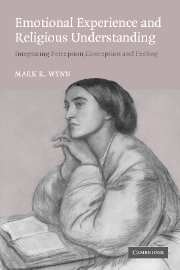Book contents
- Frontmatter
- Contents
- Preface
- Acknowledgements
- 1 Religious experience and the perception of value
- 2 Love, repentance, and the moral life
- 3 Finding and making value in the world
- 4 Emotional feeling: philosophical, psychological, and neurological perspectives
- 5 Emotional feeling and religious understanding
- 6 Representation in art and religion
- 7 The religious critique of feeling
- Bibliography
- Index
4 - Emotional feeling: philosophical, psychological, and neurological perspectives
Published online by Cambridge University Press: 03 December 2009
- Frontmatter
- Contents
- Preface
- Acknowledgements
- 1 Religious experience and the perception of value
- 2 Love, repentance, and the moral life
- 3 Finding and making value in the world
- 4 Emotional feeling: philosophical, psychological, and neurological perspectives
- 5 Emotional feeling and religious understanding
- 6 Representation in art and religion
- 7 The religious critique of feeling
- Bibliography
- Index
Summary
hearing the dominant seventh evokes a desire, and sometimes something akin to a longing, for its resolution. That is a state of consciousness directed to an intentional object; it is also an affective state of consciousness. It is not the entertaining of an evaluation which (magically) leads to certain bodily disturbances. One may, if one is so disposed, regard the desire for the tonic resolution as ground for the evaluation that such a resolution would be ‘a good thing’, but it would be a total distortion to suppose that the desire, or the longing, is an evaluation, one which inexplicably leads to certain physical effects. It is a mode of ‘feeling towards’ its intentional object.
In this passage, Geoffrey Maddell is seeking to rebut one widely influential account of the character of the emotions. On this model, we should see the emotions as compounded of thoughts and feelings: the thought component of the emotion may take the form of a belief or judgement or some non-assertional thought (such as an imagining), and this component is taken to give rise to the emotion's affective component. Take, for example, the emotional state described in this passage:
The thought that no call from him would ever again evoke the answer of her voice made him drop heavily into the chair with a loud groan, wrung out by the pain as of a keen blade piercing his breast.
- Type
- Chapter
- Information
- Emotional Experience and Religious UnderstandingIntegrating Perception, Conception and Feeling, pp. 89 - 122Publisher: Cambridge University PressPrint publication year: 2005

